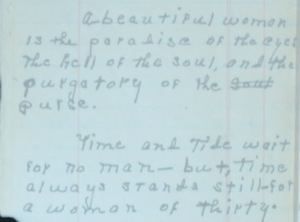Though not remotely a Ufologist myself, I’ve just watched “Roswell: First Witness” on the Blaze Freeview channel (top tip: record these and 32x fast forward through the loooong ad breaks and the almost-as-long recaps, otherwise it’ll take you all day), which threw up a couple of interesting cipher-related tidbits I thought I’d share with you.
1. Jesse A. Marcel’s Alien Alphabet
Though Jesse Marcel was neither the first to reach the Roswell debris site in July 1947 (that was actually W.W. “Mac” Brazel) nor the second (that was probably Timothy D. Proctor), he was certainly one of the first five witnesses. But I can quite see how “Roswell: Fourth Witness” probably didn’t have the required punch.
In the programme, one woman (Linda Corley) brought out a piece of paper apparently signed by Marcel, which she said Marcel had drawn to depict the alien lettering he had seen on a piece of wood-like (but not actually wood) beam-like debris. The signs reportedly resembled a series of simple curves and strokes:
( ) – / \
She then went away and looked these up, finding as a match our old friends Tironian notes. (Romans in Space! Am I the only person who remembers “The Tomorrow People: A Rift In Time” (1974) episode? Probably.) At which point Marcel allegedly span round 180 degrees and strongly asked her never to mention the lettering again etc.
To be fair, I’d say these simple curves and slashes resemble a minimalist tachygraphic alphabet, i.e. an alphabet pared down for speed and clarity rather than for expressiveness. Which is quite interesting in itself, though without necessarily being Tironian.
My question here is this: are there any UFO books out there that claim to give more examples of writing or markings in this same alphabet? I’ve never seen this mentioned anywhere else, but given that my personal library contains not even a single book on UFOs, that’s perhaps not hugely surprising.
2. Jesse A. Marcel’s Journal / Diary / Memorandum Book
Arguably the central focus of the TV programme is a notebook owned by Marcel’s descendants. Though this is mostly full of normal cursive writing, at one point in mid-1947 this halts and gets replaced by lots of curious mixed-case block-letter quotations (many now dated and sexist, *sigh*). Here are a couple screen-grabbed from the programme:
The question then arose as to whether these might have been using some kind of Baconian biliteral cipher. To try to answer this, the film-makers gave scans of the diary to Professor Craig Bauer, a mathematician who Cipher Mysteries readers will hopefully remember for his “Unsolved” (a chunky recent book on unsolved historical ciphers, with a particular authorial focus on Americana) rather than for the somewhat lame (and now totally disproven) speculations he contributed to a high(ish)-profile TV documentary series on the Zodiac Killer Ciphers.
Bauer (and presumably grad student Jack Anderson) then went away and wrote biliteral cipher decryption code to try to work out what was going on. The kinds of Baconian letter-form pairs they found looked like this:
Unfortunately their decryption attempts didn’t come up with anything worthwhile, i.e. their results were inconclusive.
However, from my own unsolved historical cipher perspective, it seems to me that Bauer et al. properly failed to test the statistical validity of their hypothesis before launching into writing code to exhaustively search the biliteral space. In other words, they didn’t look before they leaped. For example, if the ratio of each biliteral A:B letter-pair is 4:1 or worse, and moreover many of the capital forms appear word-initial (as you’d expect), something has probably already gone badly wrong with your assumptions before you even started.
In my experience, hand ciphers are primarily not about mathematics but about steganography – distracting the eye so the core of the actual cipher trundles past unnoticed. Hence you need to be sure you have cracked a cipher’s steganographic wrapper properly before you start writing any code, and I’m not sure that this preliminary sanity-checking stage happened here to the degree it should have.
Even so, though I’d be extraordinarily surprised if these quotations were concealing a message written in biliteral cipher, that’s not at all to say that they might not be concealing a message in a quite different way.
Has anyone got scans of the “Memorandum” book? I wouldn’t mind casting an independent eye on this section, see if there’s anything there to be found.



Nick,
Yes, I have a scan of the Memorandum book. The original production company, the infamous Karga Seven of “The Hunt for the Zodiac Killer” disrepute, contacted me in 2017, to look it over.
The project at that time had a working title of “Roswell Family Secrets.” The story ended up being handed off (not sure if that’s the right term) for production by a different outfit.
I found nothing of cryptologic interest whatsoever in the 24-page booklet.
I’m under an NDA until July 2022 and will be happy to share it with you at that point, along with some more details.
Spoiler alert: nothing to see here.
Bill Briere: that’s good news, thanks! I’ll definitely come back to you in July 2022. 🙂
The obvious question I have is whether you looked for the print source of the quotations? They have a kind of 1940s low-rent Reader’s Digest feel to them, a bit like a crummy newspaper column.
I did look for the sources of the quotes, partly out of curiosity about whether or not they were his own. I haven’t spent more than a minute on this in the past 4 years, though, so I’ll have to dig into my 2017 e-mails sometime. I’ll share some of those with you on or after July 3. (Don’t let the suspense kill you. Your “Reader’s Digest” assessment is more-or-less correct.)
Interestingly, my wife and I (who are not hoarders in any way, shape, or form) have boxes of 1940s Reader’s Digests that we may hang onto, for just a little bit longer, in case we need to take a deeper dive into Marcel’s quote sources.
Nick.P.
So I looked at that cipher from Jesse Marcel diary. And I must disappoint you. There is nothing written about UFOs and aliens.
Josef Z. Prof: Jesse Antoine Marcel, the TV repair man from Blue Bayou county Louisiana right? 40 years old and married with then ten year old son Jesse Jnr.
Just checked his diary entry for July 7th 1947 vis. “We spent a couple of hours Monday afternoon looking for any more parts of the weather device, we found a few more patches of tinfoil & rubber.”….Seems he hadn’t been long returned from a wartime stint in PNG, later Japan and Marshall Islands (Bikini) on post war duties. Reading twixt the lines, a non accompanied? RAAF detachment might not have bween welcomed despite promotion to light Colonel plus commendations from two generals. On discharge from full time duties in 1950 he headed back to the bayou and he gets mention as a notable citizen in the local county promotional blurb. Jesse Snr. would undoubtedly have been a ripe candidate for PTSD with its accompanying mental health issues eg., optical halucinatons and delusions IMO.
Nick, hello! I need your help decrypting some very unusual ciphers. How can I contact you ??
Apart from you, I no longer know who to turn to …
Litson Seen: my email address is (the not very hard to guess) nickpelling at nickpelling dot com, I’m always happy to discuss unusual and/or difficult ciphers. 🙂
Nick.
In the writing that is in the foto. It is written about his son. And also that he jojned the army in 1939. It also says about his wife.
It’s written like a puzzle. We will find it Czech and then in English.
ES kup.Ne dvojko.Dál kup EN. Je hoš. Už cent fo Lene end. Dej cent poesi čar. I vněm syne dou.
ES buy. Not two. Continue to buy EN. He’s a boy. ( son ). Already a cent. O Lene end. Give a cent of poetry lines. The son goes in it too.
( ES and EN )
Ti2c = Marc + ES ( ES = EL ) = MARCEL .
13 = IS = SI = 31.
Lene = Leen = wife. ES = S = 3. EN = N = 5. SN = 35 = 1935.
( ) – II = 33 – 2 = 31 and 13.
2 verse end.
A WOMON OF THIRTY.
A WO MONOF DE ARMY.
A UŽ TONOF DE ARMY.
A UŽ TONDA JDE ARMY. ( Tonda = Antonin = Antoine ).
Bauer seems to be operate in the shady area his agency is known for. He has been unforthcoming when requested to source at least one fairly lightning quote made, in his book, to me. Perhaps he did not get my email. I considered his work (in general) not unsympathetic with my interests at all. A lot of Voynich speculation for those interested. I am not fully up to snuff on the (Francis) Baconian cipher. As I mentioned numerous times, weird as it seems, I am not a code guy.
Matt